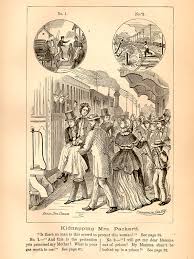
Illustration of Elizabeth Packard Being Taken Against Her Will to an Insane Asylum, courtesy National Library of Medicine
Patients who went–or were taken–to insane asylums frequently protested they were not insane and continued to do so during their treatment. Their protests fell largely on deaf ears because two particularly potent forces worked against them. The first was the presupposition of “guilt.” If they had been found insane, then they must be and of course they would protest that they weren’t. Furthermore, any violence, agitation, or emotional outbursts victims demonstrated either at commitment or during treatment would further work against them. Few people put themselves in the patients’ shoes and imagined how they would react if they were in the same situation.
Reverend Hiram Chase wrote in 1868: “I had never heard them [asylums] described , except in one instance, and that by a man who was so unfortunate as to be carried there by force by his neighbors, as most patients are carried there. He gave me a most horrible description of his treatment . . . . I heard his sad and tragical tale, but I disposed of it as most men do, by regarding the whole story as imaginary, the effect of a disordered mind, believing that such things could never be tolerated in a Christian country.”

This Belgian Cage With a Small Opening For the Patient’s Meals, Showed Just How Cruel Confinement in an Asylum Could Be, courtesy National Library of Medicine
Chase’s view was shared by many. Obviously, someone who was insane would imagine all sorts of terrible things that weren’t true. Of course a patient might be paranoid and imagine the medicine or treatment was unjustified or made him or her feel badly. Unfortunately, the frustration patients felt, their anger at injustice and sometimes false and unfair imprisonment, could lead to violent outbursts, frantic emotional responses, or negative attitudes that seemed to make it apparent that they indeed needed help.

This 1910 Article Shows That Some Former Patients Fought Back
The second factor working against patients was just as potent, and I will discuss this one in my next post.